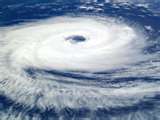Since 1953, Atlantic tropical storms have been named from lists originated
by the National Hurricane Center. They are now maintained and updated by an
international committee of the
World Meteorological Organization.
The original name lists featured only women's names. In 1979, men's names were
introduced and they alternate with the women's names. Six lists are used in rotation.
Thus, the 2005 list will be used again in 2011. Here is more information about the
history of naming hurricanes.
The only time that there is a change in the list is if a storm is so deadly
or costly that the future use of its name on a different storm would be
inappropriate for reasons of sensitivity. If that occurs, then at an annual
meeting by the WMO committee (called primarily to discuss many other issues)
the offending name is stricken from the list and another name is selected to
replace it.
Several names have been changed since the lists were created. For example, on
the 2004 list (which will be used again in 2010), Gaston has replaced Georges
and Matthew has replaced Mitch. On the 2006 list, Kirk has replaced Keith. Here
is more information about
retired hurricane names.
In the event that more than 21 named tropical cyclones occur in the Atlantic basin in a season,
additional storms will take names from the Greek alphabet:
Alpha, Beta, Gamma, Delta, and so on. If a storm forms in the off-season, it will take
the next name in the list based on the current calendar date. For example, if a
tropical cyclone formed on December 28th, it would take the name from the previous
season's list of names. If a storm formed in February, it would be named from the
subsequent season's list of names.


 N4UYB'S
N4UYB'S 



















